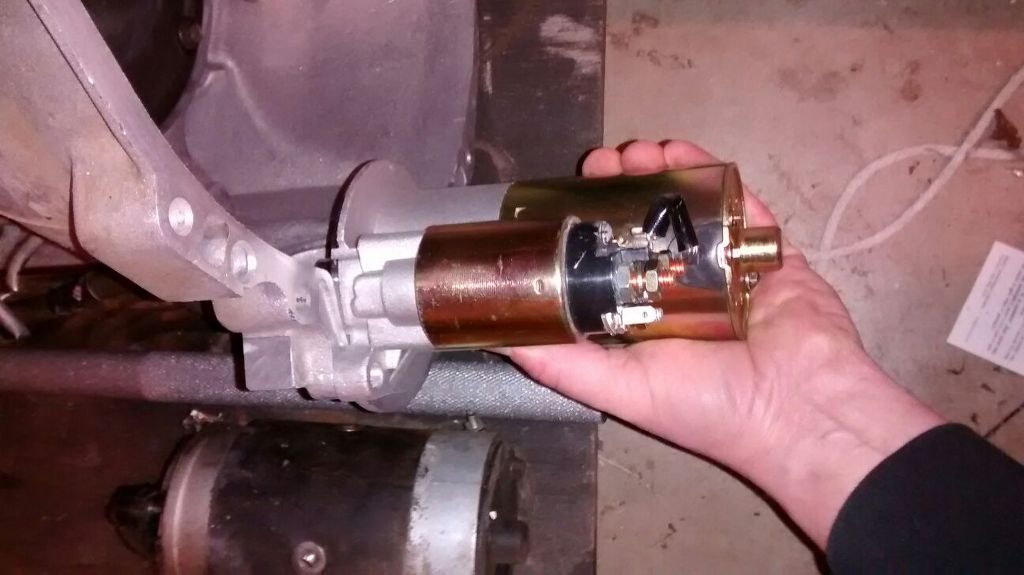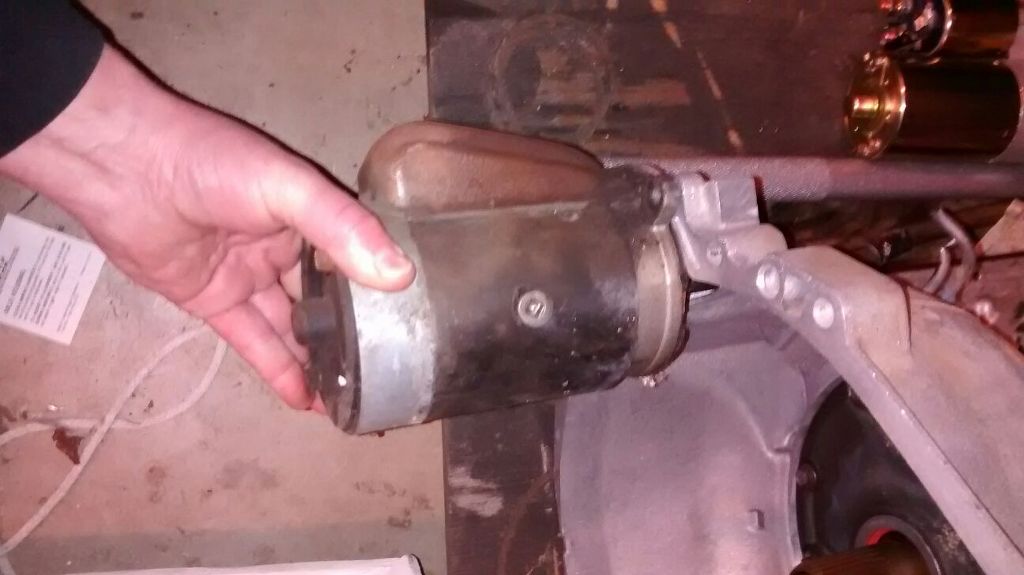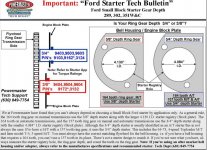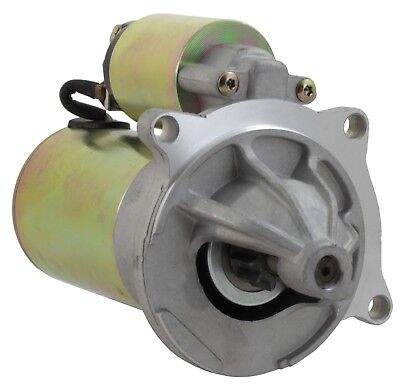Recently there was a discussion on the big six forum on using the newer small case Motorcraft or aftermarket gear reduction starters in place of the big case old style starters. These newer starters have lots of advantages like smaller diameter cases for more header clearance, less weight, faster starting, to name a few. So thought I would also share some of highlights from mine and others posts here in the small six forum as it also applies to our 250's, & low mount 200's, and many other Small Ford Sixes that uses a 2 bolt starter. Latest Update (05/16/20020) a site member recently found that the 2nd & 3rd Genteration Motorcraft two bolt starter cases (1988 to 1995) or (1996 to latest as of this post) aren't clocked correctly to be able fit (was to close or hits the block so these newer style starters aren't going to fit on any of the two bolt high mount starter blocks and bell housings this includes all the 144's, 170's, and most all 200's blocks (exception is the rare later model 200 low mount blocks plus all 250's 240's and 300's / 4.9's). So both of these newer starters are not likely to fit on any of the high mount starter blocks and bell housings without doing some custom work (see the below note).
Note: Here is a yet unproven idea, in theory if you were to unbol the two through starter case bolts so that the rear tail piece can be removed and turned to reclock it in the same position as a 1st Gen two bolt (144, 170, or a 200 Six) starter is clocked. Then It may be possable to fit the 2nd or 3rd Gen starters, by just drilling and tapping two new holes for the case through bolts in the starters nose / tail piece and also grind a new small notch for case clocking alinement pin. Other than trying this to find out the best way right now is to buy a new aftermarket PMGR Mini starter. So these newer Motorcraft 2nd & 3rd Gen starters right now will only bolt onto all the 250's, 240's and 300's / 4.9's, Six'es. And for the time being unless someone wants to do an experiment only the orginal 1st Gen starter fits the high mount blocks and Bellhousing, unless you go with one of the Aftermarket PMGR Mini Starters that are known to fit (only ones that the case can be clocked). To see the full topic go here. viewtopic.php?f=2&t=80786&p=627549#p627549
As for for the other Ford & Mercury Small Six'es 200's, 170's, & 144's', with an Auto Transmission these will use a 3 Bolt Starter your going to run into the same thing, using the stock starter or going with one of the aftermarket Mini Starters. These 3 bolt starters are based on the Ford FE V8's (332, 352, 360, 390, 406, 410, 427, & 42 . Update 5/16/2020 All 3 bolt OEM starters Ford ever made for these engines have a large case, the other choice if you want a smaller starter is getting an aftermarket PMGR Mini Starter that's made to fit an FE Ford V8 with an Auto Trans (but it must be one that case can be clocked) to be able to fit on a 144,170, and 200's High Mount Short Blocks and Auto Bellhousing. Fords has two starter drive depths 3/8 or 3/4 inch. Measure from the face of your bell housing where the starter bolts on to the ring gear to determine your depth. Generally a Manual Trans Bell Housing uses a 3/8 inch depth starter and an Auto Trans has a 3/4 inch depth. Latest Update: One of the Smallest in Size, Lightest, that's very Powerful, and is also Infinitely Adjustable for the Solenoid Position in a Mini Starter and will fit the 144, 170, and 200 Small Six's with a Ford O / or Merc O Matic and or the C4 Auto Transmissions is the RobbMc Performance Part #3001 https://www.robbmcperformance.com/products/fordat_starter.html
. Update 5/16/2020 All 3 bolt OEM starters Ford ever made for these engines have a large case, the other choice if you want a smaller starter is getting an aftermarket PMGR Mini Starter that's made to fit an FE Ford V8 with an Auto Trans (but it must be one that case can be clocked) to be able to fit on a 144,170, and 200's High Mount Short Blocks and Auto Bellhousing. Fords has two starter drive depths 3/8 or 3/4 inch. Measure from the face of your bell housing where the starter bolts on to the ring gear to determine your depth. Generally a Manual Trans Bell Housing uses a 3/8 inch depth starter and an Auto Trans has a 3/4 inch depth. Latest Update: One of the Smallest in Size, Lightest, that's very Powerful, and is also Infinitely Adjustable for the Solenoid Position in a Mini Starter and will fit the 144, 170, and 200 Small Six's with a Ford O / or Merc O Matic and or the C4 Auto Transmissions is the RobbMc Performance Part #3001 https://www.robbmcperformance.com/products/fordat_starter.html
Their are also some commonly available aftermarket gear reduction starters can be used if it's for the same application and if the Solenoid Position can be clocked in the right position. Plus there are two late OEM Ford Motorcraft starters one is a smaller case and one is a PMGR Mini HI Torque starter that might be used with a little bit of work. I remember that many of the starter rebuilders and new manufactures use a base number to ID starters for an application (not sure the correct number in this case but think it's 3157) but these particular starters will fit many Ford engines like the rare late model big bell 200's, plus all the 250, 240, 300, 4.9, 3.8, 289, 302, 351 W's & C's ect.
Econoline brought up a great point in his above post. I have seen people use shims and spacers to adapt the wrong starters and I have always just wondered why bother doing that. When you use the right tail piece on the starter you get the right starter drive depth and it fits into the starter mounting hole as it's supposed to. This has been a constant throughout on the Ford starters. The starter motors are the same the tail piece for an Auto trans needs to be used for an Auto trans Bell Housing and a Manual Trans tail piece used for a Manual Trans Bell Housing.
Just like there is a direct interchange between the old large case two bolt starters and the late model small case starters used on the 1988 up EFI engines like the 4.9, 240 / 300, 5.0, 3.8 etc.. As an example my original starter on my 1994 F150 4.9 (300) / 5 speed (small case hi torque stater) went out one day. I had a 5.0 V8 starter in the garage it's the same starter except it was for an auto trans car so I just swapped my tail end piece (starter drive section) off my 300 starter on to the 5.0 starter and popped it in worked great and the pickup was back in service in about 1 hour. Good luck

Note: Here is a yet unproven idea, in theory if you were to unbol the two through starter case bolts so that the rear tail piece can be removed and turned to reclock it in the same position as a 1st Gen two bolt (144, 170, or a 200 Six) starter is clocked. Then It may be possable to fit the 2nd or 3rd Gen starters, by just drilling and tapping two new holes for the case through bolts in the starters nose / tail piece and also grind a new small notch for case clocking alinement pin. Other than trying this to find out the best way right now is to buy a new aftermarket PMGR Mini starter. So these newer Motorcraft 2nd & 3rd Gen starters right now will only bolt onto all the 250's, 240's and 300's / 4.9's, Six'es. And for the time being unless someone wants to do an experiment only the orginal 1st Gen starter fits the high mount blocks and Bellhousing, unless you go with one of the Aftermarket PMGR Mini Starters that are known to fit (only ones that the case can be clocked). To see the full topic go here. viewtopic.php?f=2&t=80786&p=627549#p627549
As for for the other Ford & Mercury Small Six'es 200's, 170's, & 144's', with an Auto Transmission these will use a 3 Bolt Starter your going to run into the same thing, using the stock starter or going with one of the aftermarket Mini Starters. These 3 bolt starters are based on the Ford FE V8's (332, 352, 360, 390, 406, 410, 427, & 42
Their are also some commonly available aftermarket gear reduction starters can be used if it's for the same application and if the Solenoid Position can be clocked in the right position. Plus there are two late OEM Ford Motorcraft starters one is a smaller case and one is a PMGR Mini HI Torque starter that might be used with a little bit of work. I remember that many of the starter rebuilders and new manufactures use a base number to ID starters for an application (not sure the correct number in this case but think it's 3157) but these particular starters will fit many Ford engines like the rare late model big bell 200's, plus all the 250, 240, 300, 4.9, 3.8, 289, 302, 351 W's & C's ect.
Econoline:3tl610l5 said:The indexing hub of the starters is also slightly different based on application, m/t vs a/t. The Manual 2 bolt starter has a slightly larger hub and won't fit in the bore on an automatic trans. Conversely you can bolt up an automatic starter in a manual, but you would notice the loose fit in the bore.
Econoline brought up a great point in his above post. I have seen people use shims and spacers to adapt the wrong starters and I have always just wondered why bother doing that. When you use the right tail piece on the starter you get the right starter drive depth and it fits into the starter mounting hole as it's supposed to. This has been a constant throughout on the Ford starters. The starter motors are the same the tail piece for an Auto trans needs to be used for an Auto trans Bell Housing and a Manual Trans tail piece used for a Manual Trans Bell Housing.
Just like there is a direct interchange between the old large case two bolt starters and the late model small case starters used on the 1988 up EFI engines like the 4.9, 240 / 300, 5.0, 3.8 etc.. As an example my original starter on my 1994 F150 4.9 (300) / 5 speed (small case hi torque stater) went out one day. I had a 5.0 V8 starter in the garage it's the same starter except it was for an auto trans car so I just swapped my tail end piece (starter drive section) off my 300 starter on to the 5.0 starter and popped it in worked great and the pickup was back in service in about 1 hour. Good luck

Last edited:








